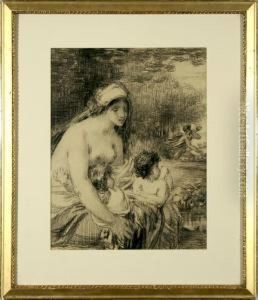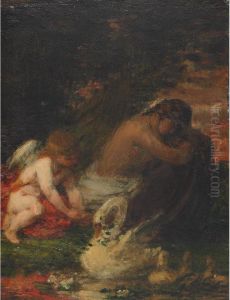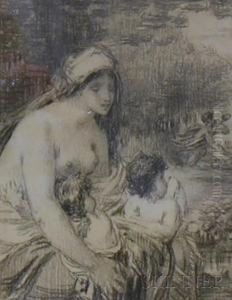William Perkins Babcock Paintings
William Perkins Babcock was an American artist born on May 21, 1826, in Boston, Massachusetts. He was known for his work as a painter, particularly in the genres of landscape and genre painting. Babcock's artistic journey began in his native Boston, but his talent and ambition soon led him to Europe, which was the center of the art world during the 19th century.
In the 1850s, Babcock moved to France to further his artistic education and career. He became part of the American expatriate community in Paris, which included many artists and writers. Babcock studied under the tutelage of Thomas Couture, a well-regarded French history painter and teacher. Under Couture's guidance, Babcock honed his skills and developed a style that incorporated elements of Romanticism with the attention to detail characteristic of the emerging Realist movement.
Babcock's work was influenced by his surroundings and by the masters of European art. He spent a significant amount of time in Italy, particularly in Florence, which was a source of inspiration for many of his landscapes. He was drawn to the serene beauty and historical resonance of the Italian countryside, which he captured in his paintings with a delicate and meticulous hand. His works often reflect a sense of tranquility and a deep appreciation for the aesthetics of the natural world.
Throughout his career, Babcock exhibited his work in various venues, including the Paris Salon, which was the official art exhibition of the Académie des Beaux-Arts in Paris. Exhibiting at the Salon was a prestigious accomplishment for any artist, and Babcock's inclusion in these exhibitions helped to establish his reputation as a skilled painter. Despite this recognition, Babcock never became as famous as some of his contemporaries.
William Perkins Babcock remained in Europe for the majority of his life, and it was there that he passed away on June 16, 1899, in Civita Castellana, Italy. Although he may not be as well-known as other artists of his time, his work is appreciated for its craftsmanship and for the glimpse it provides into the 19th-century American expatriate experience in Europe. Babcock's paintings are held in various art collections and continue to be studied by those interested in American art and the cultural exchange between the United States and Europe during the 19th century.


